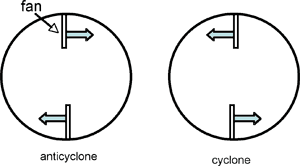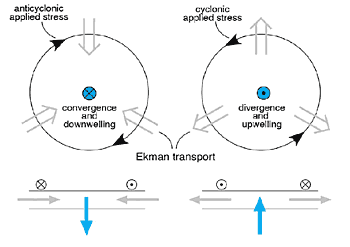Here we study the mechanism by which the wind drives ocean circulation. We will induce cyclonic and anticyclonic circulation by blowing air over the surface of a rotating tank of water using fans co-rotating with the turntable, as sketched in Fig.1. The Ekman layers and patterns of upwelling and downwelling can be made visible through the use of dye crystals and paper dots.
Fig.1 Cyclonic and anticyclonic circulation are induced by blowing air over the surface of a rotating tank of water using co-rotating fans.
The flow within the surface Ekman layer associated with the action of the wind is convergent in anticyclonic flow and divergent in cyclonic flow if the apparatus is rotating cyclonically (Ω > 0, corresponding to the northern hemisphere) as sketched in Fig.2. The convergent flow drives downward vertical motion (called Ekman pumping, left of Fig.2); the divergent flow drives upward vertical motion from beneath (called Ekman suction, right of Fig.2).
Fig.2 The Ekman transport is directed perpendicular to the applied stress (to the right if Ω > 0, to the left if Ω < 0) driving (left) convergent flow if the stress is anticyclonic and (right) divergent flow if the stress is cyclonic. (The case Ω > 0 — the northern hemisphere – is shown.)
These experiments were developed in collaboration with Professor Amit Tandon and undergrads David Beesley and Jason Olejarz of UMass Dartmouth.
For more on this project see the following paper published in Oceanography: Coriolis effects on wind-driven ocean currents

